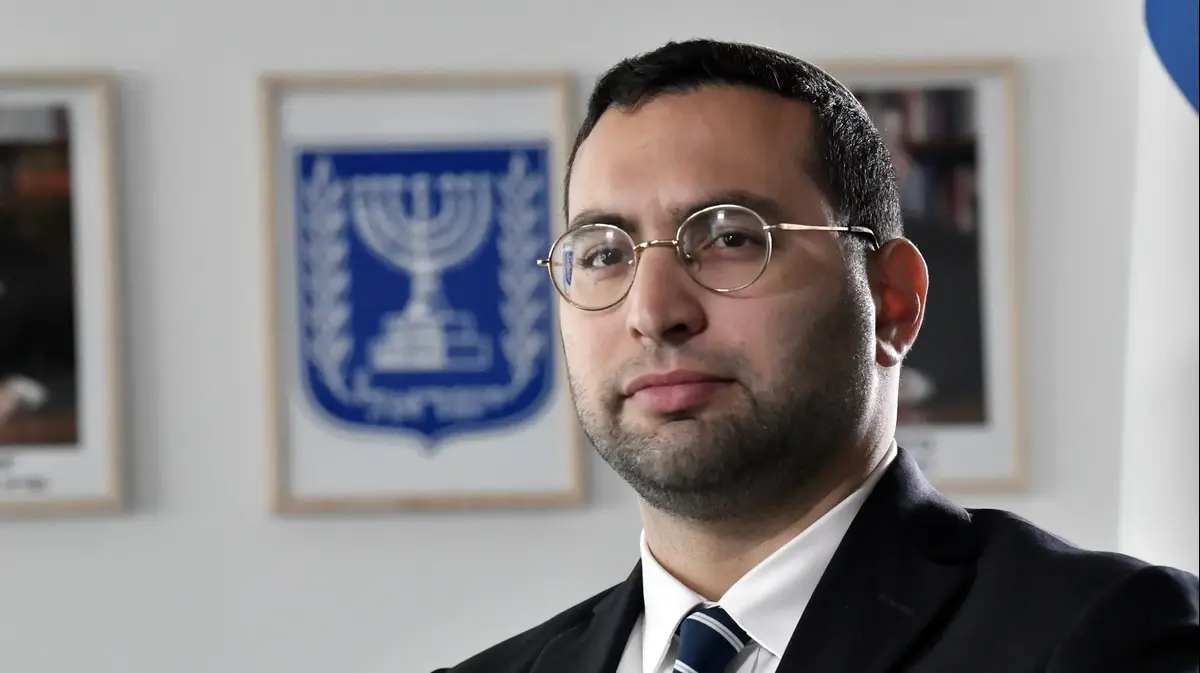Borges said that the history of thought is the history of a few metaphors. If we accept this premise, the inevitable consequence is that the inversion of a metaphor can unleash an unprecedented and revolutionary current of thought. That was the "strategy", more or less conscious, that Isaac Luria (1534-1572) followed, to turn a metaphor upside down. Until that moment, according to the Neoplatonic tradition, the One falls apart into the universe. After a series of emanations, he transfers, as it were, his life to the universe, which from that moment on is intelligent and has a soul. Luria conceives the origin in a different way. And it does so through a concept, the
tsimtsum
, which means withdrawal, withdrawal or contraction. The universe no longer expands, as in the
big bang
Neoplatonic, but contracts. For this he has to invert (revolutionize) an old proverb. According to the Talmud, God concentrated all his radiation (
shechina
) in a single point, the holiest of places, a
singularity
, as one would say in modern cosmology. For Kabbalists that concentration is, in fact, a retreat. So the existence of the universe is made possible by the flight of God, which is essential for the appearance of the world. The reasoning is simple, the world could not exist if God were everywhere. And neither could God create it from nothing if nothing (which obviously does not exist) did not exist. The life of beings, their freedom, requires divine discretion. “God was forced to make room for the world by abandoning, as it were, a zone of himself, of his interiority, a kind of mystical primordial space from which He withdrew in order to return to the world in the act of creation and revelation ”. That is, in order to make possible the religious experience and the awakening of the divine flame that exists in beings.Said in simple terms: God withdraws so that, in the exercise of freedom, beings seek him.
The metaphorical investment is complete and in line with our time. The flight of god is a cosmic phenomenon that one can experience for himself. That is the Via Luriana. The cosmogonic exile also explains a fundamental reason for Judaism: the "breaking of the vessels." The first act of divine creation is self-limitation. The retreat into the
En-sof
, the divine abyss. The second already supposes a manifestation, a ray of light, an emanation, in which God himself is the space of his own creation. A diverse and multiple creation, called
Elohim
, which is the plural aspect of divinity.
Each new emanation is like a breath, like the beat of a heart, there is a light that flows towards God and another that emanates from Him, with withdrawal, expansion occurs.
A pulsating, living universe, in which the initiate can feel the divine breath.
Ramon Llull: fantastic thinking machine
Master Eckhart: God is nothing
Ibn Arabí, the master of the moment
Schopenhauer: the theater of the mind
Einstein: the light that measures things
The flight of God served to curb the growing pantheism that proliferated in Kabbalistic circles.
Rescue an essential motif of Gnosticism.
The idea that there is a divine spark in each one of the beings, coming from the superior world, fallen in this world subjected to death and birth.
That spark must "awaken" its divine counterpart to be finally reintegrated to the origin.
Luria was essentially a theistic thinker and his reading of the
Book of Splendor
follows that direction.
The pantheistic tendencies that permeated the
Zohar
, reinforced in the Italian Renaissance, found their counterweight in it.
Exile
There is a political exile and a metaphysical one. Both are part of the Hebrew identity and have much in common with those philosophical exiles that are the ancient Gnostics and the modern existentialists. For many of them, Jews or Gentiles, exile continues to be the axis of existence and a way of being in the world. Gershom Scholem takes that feeling back to a watershed moment in history. At the beginning of the thirteenth century, the cabal is the privilege of a few, who make their forays into the mysteries of the divine in a more or less secret way. The Kabbalists of the Crown of Aragon and the Kingdom of León have produced a considerable number of texts that circulate in a restricted way. But the persecution of the Jews in the peninsula,the emergence of Marrano Judaism and the definitive expulsion in 1492 made the Kabbalah a more popular and widespread doctrine. The expulsion from Spain seemed to herald the final catastrophe and 1492 was marked as the year of redemption. However, there was no apocalypse or redemption, only a cruel exile and a material and spiritual debacle that led many Kabbalists to Palestine. The reactive exile of mysticism and mystical action became political: the need to reestablish the lost unity was no longer an exclusively religious necessity, but was transformed into a historical urgency. Political exile led to the resurgence of the doctrine of metempsychosis, where the soul in exile travels through various areas of existence. Of all of them, the most terrible is that of the absolute absence of God, more terrible than the torments of hell,which are but a way of purification. The historical and political exile awakens the consciousness of the exile of the divine, of the withdrawal of God.
Safed
Safed is a Palestinian city founded by Noah shortly after the flood, on a hill emerging from Lake Tiberias that preserved it from the waters.
The city became famous because it was taught by two Kabbalah masters: Moisés Cordovero and Isaac Luria.
Since then, Jews from all over the world have made pilgrimages to this holy place in search of his teachings.
But the history of the cabal begins much earlier, in the Kingdom of Aragon and the Kingdom of León, where the
Book of Clarity
(
Bahir
), compiled by rabbis of Provence in the 12th century, and the
Book of Splendor
(
Zohar
), written by Moisés de León a century later. At that time, on the other side of the Mediterranean, Safed belonged to the Kingdom of the Crusaders of Jerusalem and its castle was guarded by the Knights Templar. Shortly after it would be conquered by Saladino, after a siege that lasted a year. Luria lives in Safed under the rule of Sultan Suleiman I. There is a detailed record of its population: a thousand families, two hundred single and 54 Muslim religious leaders, seven hundred Jewish households, 56 single and 9 disabled. After the expulsion of the Jews from the Peninsula, Safed welcomed numerous rabbis from Spain and Portugal, and became one of the most important centers of Jewish mysticism. The influx of Sephardim reached its peak under the Sultanate of Selim II. Shortly after Luria's death,Eliezer Ashkenazi opens Safed's first Hebrew printing press.
The Tree of Life in the Kabbalah.GETTY IMAGES
Disciples and Hermeneuts
Without knowing the parts we cannot know the whole, but without a glimpse of the whole we do not know the parts. That is the bond that ties the concrete and the universal, the creature to nature. Philosophers call it a hermeneutical circle. Any abolition of the circle, any concealment of its complexity, is a hoax, more or less insidious. Bookish and scholarly traditions, such as Sanskrit or Hebrew, find themselves at home in the stormy sea of hermeneutics. In them, the interpretation of sacred texts can be a lifelong job. A respected and generally poorly paid trade. The development of culture depends largely on these reading professionals. For the Kabbalists of Safed, the scriptures offer 70 faces of God, changing these from generation to generation. If we consider that a generation is 15 years,This means that when a millennium has passed, one returns to the starting point. The meaning of the scriptures is not infinite, but it is long enough so that it is not noticed that they are repeated, that they are at the mercy of rotating signs. The
Psalms
, to cite just one example, can be read as a song book or as a war book (as an arsenal for the final combat).
Luria was trained as a rabbi in Egypt, but he lacked literary skills and hardly wrote.
His legacy, like that of Socrates, is due to the magic of his personality.
Luria was trained as a rabbi in Egypt, but he lacked literary skills and hardly wrote.
He left a deep mark on those who knew him and his legacy, like that of Socrates, is due to the magic of his personality.
Thanks to the oral transmission we know their doctrines.
His disciple Hayyim Vital (1543-1620) wrote several versions of Luria's worldview.
The Tree of Life
, the most detailed, reaches five volumes. Vital jealously guarded his works and, until his death in Damascus in 1620, none of his manuscripts were copied or circulated without his permission. When his faculties were already declining, his brother allowed himself to be bribed and gave his works in exchange for 50 pieces of gold. The manuscripts began to be copied and circulated in secret, without Vital, seriously ill, being able to prevent it. Israel Sarug acquired some of those copies stolen from Vital and, with missionary zeal, spread the Lurian Kabbalah in Italy. He was posing as a direct disciple of Luria, although he was not. Neoplatonism was then in vogue in Italy and one of its followers was Abraham Kohen Herrera, the only Kabbalist who wrote in Spanish. Descendant of a family of Marranos, he died in Amsterdam in 1639.In the synagogue of this city, a few years later, Spinoza would study, who could also read in Spanish.
Gravity and grace
There are apocalyptic kabbalists and nostalgic kabbalists.
The former are recreated in the end of time, the judgment and the final redemption.
The second, to relive the original experience of creation.
Luria belongs to the latter and it is probable that the Gnostic echoes of their cosmology come from his years of study Egypt.
There he was able to discover Gnostic manuscripts from the Talmudic period, where biblical dogmas were read in the light of Platonic categories.
For the cabal before Luria, creation was a simpler matter.
God projected his power outside of himself and, in doing so, created space.
Each new creation involved a new phase in a process of emanation or "exteriorization".
Now things get complicated. Luria is above all a visionary. We can peek into his mental universe thanks to the testimonies of those who knew him. Scholem goes so far as to affirm that "the labyrinth of the hidden world of mysticism was as familiar to him as the streets of Safed, he permanently inhabited that mysterious world and his penetrating and visionary gaze perceived fleeting gleams of psychic life in everything that surrounded him." Like most mystics, he does not distinguish between the organic and the inorganic. Souls are present everywhere and it is possible to communicate with them. Visions often assailed him, especially of the prophet Elijah. When he walks with his disciples, he is able to identify the places where the saints of the past are buried.His tolerance for the customs and rituals of the different tribes of Israel is surprising. Each one has its own entry into heaven, Sephardim and Ashkenazis can remain faithful to their rites and customs without conflict or contradiction.
Anticipating Spinoza, Luria wonders how anything other than God can exist. God withdraws to make room and that withdrawal is a way of consenting to creation. The motive is both Gnostic and Jewish. The withdrawal supposes an exile, the historical exile of the Hebrew people, and is symbolically related to the exile of the
shechina
. The model does not emerge from spiritual enlightenment, but from long years of study. The influence of Cordovero is decisive and leads to a series of magical practices censored by Orthodox Christians and Hebrews. None of this is new, the mystical and propitiatory use of the word was frequent in medieval Hasidism and the creative power of the Hebrew alphabet had already been used by the Aragonese Abraham Abulafia.
Anticipating Spinoza, Luria wonders how anything other than God can exist. God withdraws to make room and that withdrawal is a way of consenting to creation
That creation is not the consequence of an expansive divine process but of a withdrawal. The
En-sof
withdraws from the infinite space that its Presence occupied so that the world can appear. The model also explains the existence of evil, a consequence of this withdrawal, and the very possibility of freedom. The death of God, which Nietzsche and Darwin will certify, has a precursor here. The effort of the people of Israel to adhere to the divine cause, through its mystique of prayer and the fulfillment of the law, is oriented to the reestablishment of that divine source in exile. It is in that sense, Luria is not only a doctor of the soul, he is also a healer of the cosmos.
There is also another, genuine idea of this Hebrew tradition: originally, something went wrong. The rigor of divine justice caused the "breaking of the vessels." The divine light of the
sefirot
breaks into space. But created things, unable to contain the force of radiation, break. The
radiance
of God (
shechina
) must be withdrawn to allow creation to begin. The evil originates precisely from that "breaking of the vessels", it is a collateral effect of the purification process of the
sefirot
, of limiting the excesses of divine rigor and making grace possible. A situation that gives meaning to religious life, to that tendency, innate in man, to
rejoin
to the origin. God has limited himself and, in doing so, has limited the rigor of his justice. Leibniz (who frequented the cabal as a young man) will pick up this idea: we live in the best of all possible worlds. Grace or love is the essential counterweight to that justice. That is the essential tension that maintains the universal pulse and breath. Grace is expansive (
Elohim
), justice contractive (
En-sof
). A short time later, Spinoza defined reason as the "harmony of the passions." God had to limit his passion for justice, temper his supreme fairness, to make grace and love possible. In this way the apparent contradiction between justice and grace is resolved. Grace, like gift or favor, eludes the laws of merit, which are those of justice. In grace, everything is gratuitous and supernatural favor, indult or occasional help, which suspends divine severity. In addition, grace gives vitality to the world, makes the unexpected and surprising possible.
Thanks to divine contraction (
tsimtsum
), things can be what they are and remain within their own limits: the cell in the membrane, the creature in the skin. That is the way they can preserve their identity. Now, if that justice were severe, if it were not dissolved in the ocean of mercy, things could not change, and we would live in a petrified universe. So divine limitation not only makes grace possible, but ensures transformation and evolution of things. The natural universe is a consequence of that balance between the masculine and the feminine, between the rigor of justice and the grace of compassion (the balance between
karma
and compassion, as Buddhism would say).
According to the Midrash, at first the world was going to be based on strict judgment, but God saw that this was not enough to guarantee its existence and added the quality of mercy.
From that retreat, a residue of light remained (as if it were the event horizon of a black hole), within the original space of creation.
That is the root of the divine judgment that subsists in things.
And then, in a second movement, one can speak of emanation, of an expansive and luminous radiation, sent from the abyss withdrawn from the
En-sof
, which orders chaotic matter.
The faces of God
The first being that emanated from the
En-sof
into the primordial space, the first configuration of the divine light, was the
Adam Cadmon
. Primordial man (replica of the original puruṣa of the Vedas) is the first creation, the first manifestation of divinity after his withdrawal. From his eyes, from his mouth and ears and nose emerges the divine light of the
sefirot
. That light is destined to create finite beings and must be conserved in "containers". So it is with the three
sefirot
higher, but when it is the turn of the lower ones, the impact of the light breaks the containers. This is how Luria interprets the “rupture of the vessels”. In ancient literature there are references to a destruction of the worlds prior to the current creation. The judgment not mitigated by compassion ends up destroying creation, which needs the balance between rigor and grace, the harmony between the masculine and the feminine.
For the
Zohar
, the six
sefirot
correspond to the six days of creation. Each one represents a face or aspect of God (they are analogous to the Dignities of Ramon Llull), and they manifest his personality from a particular perspective. Luria describes the cosmic drama with the tone of the Gnostic myths (Basilides, Valentine). The main faces are five and collect the symbolism of the
Zohar
, but with a new meaning. When pure mercy and divine love contained in the supreme sefira (crown) merge, they give rise to "The Long Face", the resigned and merciful God, called the "Holy Elder". The second and third sefirás, wisdom and intelligence, become the face of "father and mother." The powers of the six lower sefirás (except the
shechina
), in which mercy, justice and compassion are in balance, configure another face, the "Impatient", in which severe judgment plays an important role. What is interesting about all these configurations or faces of divine light is the complex and multifaceted personality of the Supreme.
For Luria, there are two principles that govern the living God: the "Impatient" and "Rachel" (symbol of the
shechina
). Through this tension, God "gives light to himself" and develops his own personality. Scholem asks: “Is
En-sof
the personal God (the God of Israel) and are all his“ faces ”just manifestations of his different aspects? Or is it the impersonal substance, the
deus absconditus
, which is transformed into a person through their "faces"? Where is the living God in all this drama? According to Cordovero, the real God to whom the religious cult is directed is the
En-sof
, while the
sefirot
they are nothing more than the organism through which it constitutes itself into a living God, which enables it not only to create, but also to act in the natural world.
For Luria, however, the
En-sof
lacks religious or devotional interest.
The prayers of devotion are directed to the faces, which are its manifestation, not to the abstract and formless abyss of the
En-sof
.
Like Paul of Tarsus, for Luria the cosmic process takes place within God
Like Paul of Tarsus, for Luria the cosmic process takes place within God.
After the withdrawal of the divine substance into the abyss of
En-sof
, a vestige or residue of divine light remained floating in space.
That remainder, which plays an important role in Hindu cosmologies and in the Gnostic Basilides (the Pneuma was left empty but impregnated with the aroma of the one who had left), Luria compares (as was done in India) with the aroma of wine or wine. oil left in a bottle that is emptied.
In any creative act there is a prior withdrawal, as in the silence prior to speaking or in the solitude of the artist who prepares his work.
18th century birth amulet Heritage Images / GETTY IMAGES
The transmigration of souls
Man's mission does not end in this life, but finds continuity in the transmigration of the soul (
guilgul
). The doctrine will be elaborated in detail by Hayyim Vital. As we have seen, transmigration is a metaphor for exile, each individual soul retains its personality until the moment in which it has made its own spiritual restoration, its contribution to cosmic restoration (
ticún
). Those who have succeeded do not transmigrate and await, in a blessed place, their reintegration into the soul of Adam. Transmigration is not a sentence but an opportunity, the opportunity to fulfill the precepts. Transmigration to other areas of the natural world (plants, animals or minerals) is a particularly harsh form of "exile" (and it will be said that this is the reason why the people of Israel will be dispersed to the four winds and enslaved by the other towns). The true history of the world consists precisely in these "displacements" between different areas of existence (thereby inaugurating a new way of interpreting Scripture). Thus, the
guilgul
becomes part of the restoration process of
Ticún
.
The transit is long, but it can be shortened by ritual.
Each person bears inscribed, in their hands and on their forehead, the secret itinerary of their transmigration.
And those who are able to decipher that script can help the soul.
Restitution
As in Leibniz, the
Zohar
defines evil as a by-product of the creative process. The best of all possible worlds must contain the seed of evil, for it makes freedom possible. The Kabbalists before Luria had related the "breaking of the vessels" with the growth of the seed that germinates and ends up flourishing. The containers broke and the light spread, leaving sparks in its wake. The diabolical worlds (288) infiltrated creation and the positive elements mixed with the negative ones. A new stream of light emanates from the
En-sof
, with the glasses already broken, and each sephira draws one of their faces.
Luria influenced many aspects of Jewish life, from the sexual life to the understanding of death.
He combined the two great symbols of Jewish mysticism: exile and redemption
The sparks of the
shechina
they are scattered in the various worlds. There is no realm of existence, be it organic or inorganic, in which they do not shine. The Gnostic restitution of the divine spark to its origin resounds here. Perhaps this idea inspired Luria's doctrine of restitution, which posits a unity of destiny between man and God. Through it, man can (and should) influence God's destiny. The restitution of the scattered lights of the divine to their rightful place. What is decisive here, as Scholem points out, is that "the process by which God conceives, generates and develops himself does not reach its conclusion in God." Furthermore, "some aspects of the restitution process correspond to the man." Not all the lights that are captive by darkness free themselves, man must participate in that rescue work.It is he who completes the enthronement of God, "the one who gives the last touch to the divine face." Man not only helps the creator, but contributes to his perfection. Divine and human existence are intertwined. The idea strengthens the conception of a national God, the diaspora and the messianic character of the people of Israel. The historical path towards the end of time runs parallel to the path towards the restitution of the original harmony. Return of things to contract first. The external aspect of the world (history) depends on the internal recollection. Restitution is that task capable of restoring the unity of God's name, broken with original sin, which separated the letters YH from the VH. The concentration of intention in prayer, the soul's groping search on the dangerous path to the divine,the prayers that protect the initiate from being flooded by the waters of ecstasy work in that direction. At the same time, it aims to end the exile of the
Shechinah
and restore it to its original place, as the people of Israel must be restored to their Original Land. It is a collective effort. “Each person has something of his neighbor. Whoever sins not only harms himself, but also that part of himself that belongs to another ”(Cordovero). The Torah urges you to love the other as yourself because the other is really yourself. Within this general framework of reconstruction of the divine puzzle (the Gnostic gathering of the scattered sparks), returning Rachel (the
shechina
) to her Lord is the ultimate goal.
Luria influenced many aspects of Jewish life throughout the diaspora, from sexual life to understanding of death.
He combined the two great symbols of Jewish mysticism: exile and redemption.
It is up to the person to put an end to the first and consummate the second.
Tradition is aware that magic and inner concentration (in prayer or ritual) can influence the outside world as magic or technique does.
The secret doctrine has a danger: degeneration into magic.
A route that, as in Bruno, is the starting gun of the modern world.
The technological devotion has only just begun.
You can follow BABELIA on
and
, or sign up here to receive
our weekly newsletter
.









